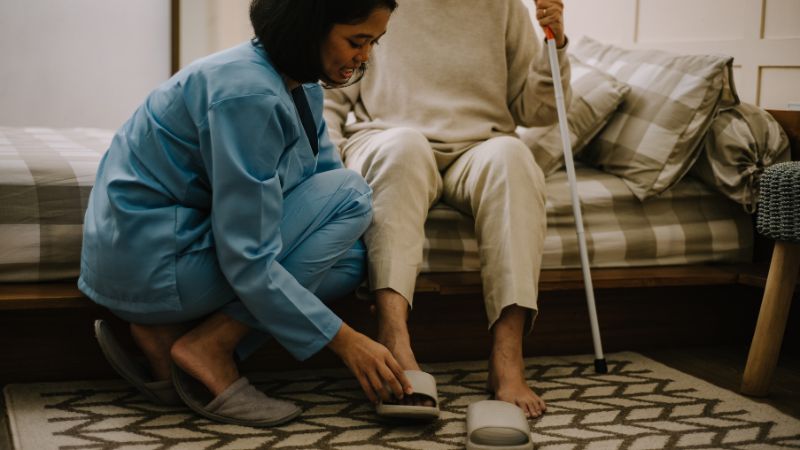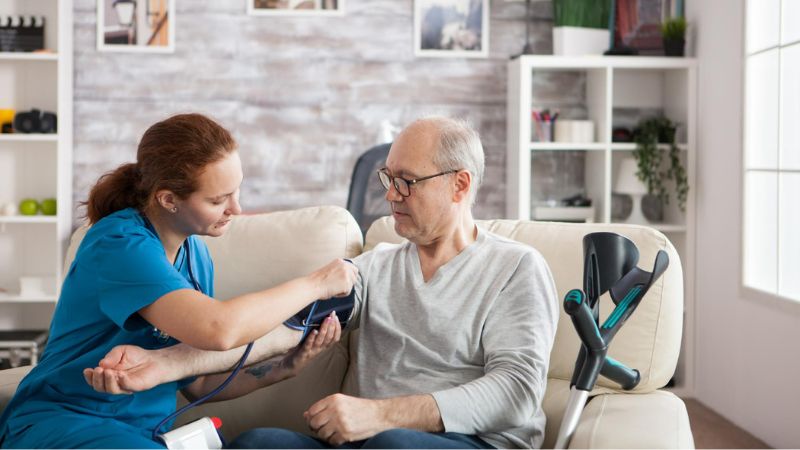For Care Recipients
CDPAP: A Pathway to More Independent Living

A chronically ill person or a person living with some form of disability faces a lot of problems if he wants to live independently. Today, the Consumer Directed Personal Assistance Program (CDPAP) and similar programs actively support the capability and adeptness of managing one’s care.
That is unique in the sense that the persons would have the opportunity to exercise control over who would be helping them and how much help should be rendered. This naturally brings about a degree of independence that is not allowed under the traditional models of home care. This essay will discuss what CDPAP is, the benefits that come with it, and how this is the most important path towards living independently.
About CDPAP
The Consumer Directed Personal Assistance Program is Medicaid that allows a way of letting people have control over the services they take for their health care.
That would respect day-to-day care as a most personal matter and, therefore, it allows the patient, or ‘consumer,’ to both hire and direct his or her caregiver. Consumers can hire an assistant from just about anywhere—most family members, friends, or acquaintances—provided the person is legally eligible to work in the U.S. Thus, this direct hiring avoids many complications and restrictions inherent when consumers arrange their care through traditional home care agencies.
Key Features of CDPAP
Freedom to Choose Caregivers: Traditional home care agencies provide caregivers whose skills and temperaments remain varied; however, CDPAP offers consumers the opportunity to hire people they trust and are comfortable with, including friends and family.
Flexibility in Care and Scheduling: The customer defines and supervises his daily care routine. He gets help at a time that suits him and is most relevant to his activities of daily living and lifestyle, not at the time when the agency schedules their visits.
No Formal Training Required: CDPAP caregivers are not required to have formal certification. This setting allows the individual to relate well with personal rapport and recognize that the value in caregiving is something that comes from a personal connection and thus affords more of an intuitive, empathetic approach to care.
Empowerment and Independence: As a result, the customers can take charge of their lives, since they manage the service delivery care assistants, hence empowerment enhances mental and emotional health since the individuals would remain active in making their own decisions.
Benefits of CDPAP
Improved Quality of Life Beneficiaries of CDPAP are said to enjoy an increased quality of life emanating from comfort and care provision by familiar and trusted people from their homes, which are secure and private. However, taking over control of one’s care routine can substantially lift one’s spirits in that it preserves dignity and contributes to independence.
Customized Care The caregiver is usually a family member or friend, therefore, he knows the needs, preferences, and medical conditions of the consumer. The knowledge enables the provision of service that is very personal and attentive, nothing compared to the services usually offered at the care of normal homes.
Emotional and Psychological Benefits Caregivers can also, in turn, obtain remarkable emotional and psychological gains from being a caregiver while they maintain relationships with their loved ones. In most cases, caregivers offer much more than just physical support but help answer a great emotional need that would otherwise be wanting to face the challenges of incapacitating chronic illness or disability.
Challenges and Considerations
While CDPAP offers numerous advantages, there are some considerations to keep in mind:
Navigating Medicaid Eligibility: CDPAP is difficult to navigate because a person must be Medicaid-eligible to qualify. The administrative responsibility lies solely with the consumer, who needs to tend to payroll and other administration issues entailed in hiring the caregivers if one is to do so without guidance.
Caregiver burnout: in some cases, seeking out family members or friends to be responsible for taking care of the person can result in burnout, since the individual will normally also have to integrate this new responsibility with existing personal ones.
Is CDPAP Right for You?
CDPAP represents a legitimate and sensitive option for those under Medicaid who would like to have a voice in their well-being, as opposed to the current allowance. At the core of its mission, it realizes that personal control arises as a function of the kind of well-being that comes from familiar, personalized care. If you are one, or someone who loves to watch the show under Medicaid, then CDPAP is quite curious to value. It stands as the type of compassionate home care service by helps in the personalized network in the environments for care and by helping in the crafting and support needed.
If you have questions or need guidance about starting with CDPAP, consulting with healthcare professionals or direct contact with the Department of Health can provide the next steps. Remember, choosing the right care path is a significant decision that can reshape lives—making informed choices is key to navigating this journey toward a more independent and fulfilling life.
Leveraging CDPAP for Long-Term Health and Well-being

Navigating long-term healthcare needs can be a complex and daunting task for individuals with chronic conditions or disabilities. The Consumer Directed Personal Assistance Program (CDPAP) provides a lifeline by offering a way to manage these needs through self-directed care. This innovative program not only puts individuals in the driver’s seat regarding their care decisions but also promises to enhance their long-term health and overall well-being. Let’s explore how CDPAP works and the profound impact it can have on those it serves.
Key Benefits of CDPAP for Long-Term Health and Well-being
Customized Care Plans:
Personalization is at the heart of CDPAP. Consumers can tailor their care plans to fit their specific needs, adjusting as their health conditions change over time. This flexibility ensures that the care regimen remains relevant and effective, promoting better health management and preventing complications.
Consistency and Continuity of Care:
One of the greatest advantages of CDPAP is the consistency it offers. Caregivers who know the consumer well are less likely to misinterpret needs and more likely to notice changes in health status, allowing for timely medical interventions. This continuity comforts the consumer and plays a crucial role in managing chronic health issues effectively.
Enhanced Emotional and Mental Health:
Mental health is as important as physical health, especially for those dealing with long-term conditions. CDPAP’s model reduces stress and anxiety associated with receiving care from strangers and enhances psychological well-being by maintaining important personal relationships.
Empowerment Leads to Better Health Outcomes:
Empowerment is a powerful determinant of health outcomes. By giving consumers control over their care decisions, CDPAP boosts their autonomy and engagement with their health management, which can lead to better overall health outcomes.
Leveraging CDPAP for Sustainable Well-being
Building a Supportive Care Network:
Through CDPAP, consumers can establish a robust support system by involving caregivers who are emotionally invested in their well-being. This network not only aids in day-to-day care but also provides a critical safety net that supports the consumer’s long-term health objectives.
Preventive Health Management:
With caregivers attuned to the nuances of their health conditions, consumers can better adhere to preventive measures and routine health checks. This proactive approach is essential in avoiding hospitalizations and managing health issues over the long term.
Education and Training:
While CDPAP caregivers are not required to have formal medical training, many families invest in basic healthcare training to manage conditions more effectively. This educational approach ensures that the care provided is informed, safe, and up-to-date.
Embracing a New Paradigm in Care
CDPAP is more than just a caregiving program—it is a paradigm shift in how care is perceived and delivered. It acknowledges the integral role of personal choice and familiarity in promoting health and well-being. For New Yorkers eligible for Medicaid who require long-term care, CDPAP offers a promising avenue to not only meet their medical needs but also enhance their quality of life.
If you or a loved one are exploring options for long-term care, consider how CDPAP can be tailored to support not just survival, but a thriving, empowered life. Engaging with a healthcare advisor or local social services can provide further insights and guidance on making the most of this transformative program.
Your Care, Your Way: A Complete Guide to CDPAP for Care Recipients

Navigating the world of home care can be daunting, especially when looking for options that offer both quality care and independence. Enter the Consumer Directed Personal Assistance Program (CDPAP), a beacon of hope for many seeking personalized home care. This comprehensive guide delves into the heart of CDPAP, offering care recipients an insightful look into how this program can empower them to manage their care according to their specific needs and preferences.
Who is Eligible for CDPAP?
Eligibility for CDPAP hinges on a few critical factors:
- You must be a recipient of Medicaid.
- You require assistance with activities of daily living (ADLs) or skilled nursing services.
- You are capable of making informed decisions about your care or have a designated representative who can make those decisions on your behalf.
The Benefits of CDPAP:
Personalized Care
Under CDPAP, care is tailored to your unique needs and schedule. This personalization ensures that your care plan aligns with your lifestyle and preferences, promoting a higher quality of life and independence.
Choose Your Caregiver
The ability to choose your caregiver is perhaps the most liberating aspect of CDPAP. Hiring someone you know and trust enhances the care experience, providing comfort and peace of mind for both you and your family.
Flexibility
CDPAP offers flexibility not found in traditional home care models. Caregivers can perform a wide range of services, from assistance with ADLs to performing certain skilled nursing tasks, depending on the care recipient’s needs.
Empowerment and Independence
By directing your own care, you maintain autonomy over your life, fostering a sense of empowerment and independence. This control can significantly improve your overall well-being and satisfaction with your care.
How to Apply for CDPAP
Medicaid Enrollment: Ensure you’re enrolled in Medicaid, as it’s a prerequisite for CDPAP.
Needs Assessment: Contact your local social services office to request a needs assessment, which will determine your eligibility and the amount of care hours you’re entitled to.
Choose a Fiscal Intermediary (FI): An FI handles the administrative aspects of CDPAP, including caregiver payroll and compliance with labor laws. You’ll need to select an FI to work with.
Hire Your Caregiver: Once you’re approved, you can hire your caregiver. They’ll need to complete the necessary paperwork and meet any requirements set by the FI.
Navigating Challenges
While CDPAP offers numerous benefits, navigating the program can be complex. Challenges may include understanding Medicaid eligibility, selecting the right FI, and managing caregiver responsibilities. It’s crucial to seek guidance and support from local resources, social workers, or CDPAP specialists to ensure a smooth process.
CDPAP represents a paradigm shift in home care, placing the power of choice and control in the hands of care recipients. This program not only champions independence but also acknowledges the invaluable role personal relationships play in providing effective care.
For those eligible, CDPAP can be a life-changing opportunity to receive care your way, ensuring your needs are met with dignity, respect, and love. As you embark on this journey, remember that you’re not just a care recipient; you’re the director of your care narrative, shaping your path to independence and quality living.
Navigating Your Care Options: Why CDPAP Could Be Your Best Choice

In the quest for the right home care solution, the myriad of options available can be overwhelming. Yet, amidst the sea of possibilities, the Consumer Directed Personal Assistance Program (CDPAP) stands out as a beacon for those valuing autonomy, personalized care, and the comfort of being cared for by someone they trust. This blog navigates through the complexities of home care choices and highlights why CDPAP could be the optimal choice for you or your loved one.
Understanding the Landscape of Home Care
Home care services range from traditional home health agencies, which provide caregivers assigned to you, to private hires, where you directly employ a caregiver. Each option has its benefits and challenges, including varying degrees of control over caregiver selection, flexibility in scheduling, and the level of personal care received.
Enter CDPAP: A Game-Changer in Home Care
CDPAP is a Medicaid program designed to give you or your loved one more control over your care by allowing you to choose your caregiver, who can even be a family member, friend, or acquaintance. This model not only empowers you to make decisions about your care but also fosters a more personalized and comfortable care environment. Here’s why CDPAP could be your best choice:
Autonomy and Control
Unlike traditional home care services, CDPAP puts you in the driver’s seat. You have the autonomy to hire, train, and direct your caregiver, ensuring that your care aligns perfectly with your needs, lifestyle, and preferences. This level of control is empowering and can lead to higher satisfaction and better overall care outcomes.
Personalized Care from Someone You Trust
The heart of CDPAP lies in the personal connection between you and your caregiver. Being cared for by someone you know and trust not only enhances your comfort and safety but also promotes a more compassionate and responsive care experience. This trusted individual understands your unique needs, making personalized care a reality.
Flexibility and Convenience
CDPAP offers unmatched flexibility in scheduling and care routines, accommodating your lifestyle and specific care requirements. Whether you need assistance with daily living activities, medical needs, or both, your caregiver can adapt to your schedule and preferences, making life simpler and more enjoyable.
Emotional and Psychological Benefits
Receiving care from a loved one or a trusted individual has profound emotional and psychological benefits. It can strengthen bonds, reduce feelings of isolation, and improve mental health. Knowing that your caregiver genuinely cares about your well-being can make a significant difference in your care journey.
Financial Viability
For caregivers, particularly family members who might have to reduce their work hours or quit their jobs to provide care, CDPAP offers compensation for their invaluable work. This financial aspect can relieve some of the economic pressures on families, making it a viable option for both care recipients and caregivers.
Making an Informed Decision
Choosing CDPAP as your home care solution requires careful consideration of your needs, Medicaid eligibility, and the willingness and ability of your chosen caregiver to provide care. It’s important to consult with healthcare professionals, social workers, or CDPAP specialists to understand the specifics of the program and how it can be tailored to your situation.
Navigating your care options is a pivotal step toward ensuring your or your loved one’s well-being. CDPAP stands out as a compelling choice for those who prioritize autonomy, personalized care, and the emotional comfort of being cared for by someone they trust. By offering control, flexibility, and financial benefits, CDPAP not only transforms the care experience but also enhances the quality of life for care recipients and caregivers alike. As you consider your home care options, CDPAP could indeed be your best choice, embodying the essence of care that is truly by your design.
From Family to Caregivers: How CDPAP Strengthens Bonds and Care Quality

CDPAP has emerged as a revolutionary model that blurs the lines between family roles and professional caregiving. This transformative program not only elevates the quality of care but also fortifies the emotional bonds within families. Here’s a deep dive into how CDPAP is reshaping care delivery and strengthening family connections, making it a beacon of hope for many.
Strengthening Family Bonds Through Care:
Emotional Support Meets Professional Care
CDPAP recognizes the unparalleled emotional support that family members can provide. Transforming a family member into a caregiver under this program means that care is not just a professional service but an extension of the family relationship. This duality enhances the care recipient’s emotional well-being, which is crucial for overall health.
Encouraging Mutual Understanding and Respect
When family members step into the role of caregivers, there’s a profound deepening of understanding and respect. Caregivers gain insights into the daily challenges faced by their loved ones, while care recipients feel truly seen and supported. This mutual appreciation fosters a stronger, more resilient bond.
Shared Experiences Create Lasting Memories
The journey of caregiving is filled with shared experiences that become treasured memories, reinforcing the family bond. Whether it’s overcoming a health challenge together or enjoying simple moments of joy, these experiences enrich the relationship, making it more meaningful.
Enhancing Care Quality with Personalized Attention:
Tailored Care Plans
Under CDPAP, caregivers can tailor care plans to the exact needs and preferences of the care recipient. This personalized approach ensures that care is not only effective but also aligns with the individual’s lifestyle and wishes, leading to better health outcomes.
Flexibility and Responsiveness
Family caregivers can adapt and respond to changes in the care recipient’s condition with agility, something that might be challenging in more rigid care structures. This flexibility ensures that care evolves as needed, providing optimal support at all times.
Continuity of Care
Continuity is crucial for effective care, and who better to provide this than family members? Their deep understanding of the care recipient’s history, needs, and preferences ensures a consistency in care that greatly benefits the individual’s health and well-being.
The Economic and Psychological Advantages:
Compensation for Caregivers
CDPAP compensates family members for their caregiving efforts, acknowledging their invaluable work and providing financial support. This compensation can alleviate financial stress, allowing families to focus more on care and less on economic concerns.
Psychological Benefits for Both Parties
The program offers significant psychological benefits, including a sense of purpose for the caregiver and a feeling of security and love for the care recipient. This mutual psychological uplift can enhance the overall health and happiness of both parties.
The Consumer Directed Personal Assistance Program (CDPAP) stands as a testament to the power of family and the intrinsic value of care grounded in love, trust, and understanding. By transforming family members into caregivers, CDPAP not only elevates the quality of care but also strengthens the bonds that tie families together. As more individuals and families discover the benefits of this program, it’s clear that CDPAP is not just changing the landscape of home care; it’s enriching lives and relationships, one family at a time.
Understanding CDPAP: A Step-by-Step Guide for New Care Recipients

Navigating the world of home care can be a daunting task, especially for those new to the process. The Consumer Directed Personal Assistance Program (CDPAP) offers a unique approach to home care, putting you in control. This step-by-step guide is designed to help new care recipients understand how CDPAP works and how to get started with the program.
Step 1: Determine Eligibility
Who is Eligible?
- Individuals who are eligible for Medicaid.
- Those in need of help with activities of daily living (ADLs) or skilled nursing services.
- Persons capable of making informed decisions about their care or who have a designated representative who can make these decisions.
Step 2: Apply for Medicaid (If You Haven’t Already)
Before you can benefit from CDPAP, you need to be enrolled in Medicaid. If you are not already enrolled, you’ll need to apply through your local Department of Social Services. The process involves submitting an application and providing documentation to prove your eligibility.
Step 3: Obtain a Medical Order for Home Care
You will need a doctor’s order stating that you require home care services. This involves a visit to your healthcare provider, who will assess your needs and write an order for the type and amount of care you require.
Step 4: Choose a Fiscal Intermediary (FI)
A Fiscal Intermediary (FI) is an organization that handles the payroll and other administrative aspects of CDPAP for you. After receiving your doctor’s order, contact your local Department of Social Services or a Medicaid representative to get a list of approved FIs and choose one that best fits your needs.
Step 5: Recruit Your Caregiver
Under CDPAP, you can hire almost anyone to be your caregiver, including most family members, friends, or acquaintances. The key exceptions are your spouse or a parent if you are a minor child. Discuss the role with potential caregivers to ensure they are willing and able to meet your needs.
Step 6: Complete Caregiver Training
While CDPAP caregivers do not need formal certifications, they must be competent in providing the care you require. It’s your responsibility (or your designated representative’s) to train your caregiver in the specific tasks they will need to perform.
Step 7: Manage Your Care
As a CDPAP recipient, you or your designated representative will manage the caregiver(s). This includes creating a schedule, instructing them on your care needs, and communicating any changes in your health or care requirements.
Step 8: Stay in Touch with Your FI
Your Fiscal Intermediary plays a crucial role in the smooth operation of your CDPAP services. Keep them informed of any changes to your care needs, caregiver status, or personal information. They will handle payroll for your caregiver and ensure compliance with all legal and program requirements.
CDPAP offers an empowering alternative to traditional home care services, giving you the freedom to choose who provides your care and how it is delivered. By following these steps, you can navigate the CDPAP process with confidence, ensuring you receive the personalized, high-quality care you deserve. Remember, every individual’s situation is unique, so don’t hesitate to seek guidance from healthcare professionals, social workers, or your FI as you embark on your CDPAP journey.
Maximizing Your Care Experience with CDPAP: Tips and Strategies

The Consumer Directed Personal Assistance Program (CDPAP) offers a unique opportunity for those in need of home care to take control of their care experience. Unlike traditional home care models, CDPAP empowers individuals to hire, train, and manage their caregivers, who can be family members, friends, or acquaintances. This personalized approach to care not only enhances the quality of service but also strengthens the bond between the caregiver and the care recipient. To help you make the most of this innovative program, here are essential tips and strategies for maximizing your care experience with CDPAP.
Understand the Program Thoroughly
Before diving into CDPAP, it’s crucial to have a deep understanding of how the program works, its requirements, and what it entails for both care recipients and caregivers. Familiarize yourself with the eligibility criteria, the role of Fiscal Intermediaries (FIs), and the responsibilities that come with managing your care. Knowledge is power, and a thorough understanding of CDPAP will help you navigate the program more effectively.
Choose the Right Caregiver
The cornerstone of CDPAP is the ability to choose your caregiver. When selecting someone, consider not only their willingness and ability to provide care but also the compatibility of your personalities and schedules. The right caregiver is someone who understands your needs, respects your preferences, and has the emotional and physical capacity to support you.
Develop a Comprehensive Care Plan
A well-thought-out care plan is essential for ensuring that all your needs are met. Work closely with your caregiver to outline the specific tasks they will perform, including personal care, medical needs, household duties, and any other assistance you require. Be clear about your expectations and the standards of care you wish to maintain.
Invest in Training and Communication
Even if your caregiver is someone you know well, proper training and open communication are key to a successful care relationship. Provide them with all the necessary information and resources to perform their duties effectively. Regularly discuss the care plan to make any needed adjustments and ensure that both of you are comfortable with the arrangements.
Stay Organized and Keep Records
Organizing schedules, tasks, and any medical information is vital for smooth day-to-day operations. Keep detailed records of care provided, medications administered, and any changes in your health condition. This documentation can be invaluable for monitoring your health over time and making informed decisions about your care.
Build a Supportive Relationship
A positive and supportive relationship between you and your caregiver is fundamental to maximizing your care experience. Recognize the hard work and dedication of your caregiver, and ensure they feel valued and respected. A strong, positive relationship can greatly enhance the quality of care and your overall satisfaction with the program.
Regularly Review and Adjust Your Care Plan
Your needs and circumstances may change over time, so it’s important to periodically review your care plan with your caregiver. Be open to making adjustments to ensure that your care continues to meet your needs effectively. This flexibility can help maintain a high quality of care and adapt to any new challenges that may arise.
CDPAP offers an empowering approach to home care, allowing individuals to receive personalized care from someone they trust. By understanding the program, choosing the right caregiver, and fostering a positive relationship, you can significantly enhance your care experience. Remember, the goal of CDPAP is not just to provide necessary care but to do so in a way that respects your independence and enriches your life. With the right strategies in place, you can maximize the benefits of this unique program and enjoy a higher quality of care tailored to your individual needs.
Navigating the Shift: Transitioning to CDPAP from Traditional Home Care Services

The healthcare landscape is continuously evolving, offering more personalized and patient-centered care options. One such innovation is the Consumer Directed Personal Assistance Program (CDPAP), a paradigm shift for many from traditional home care services. Transitioning to CDPAP can be a journey of empowerment and personalization but may also present challenges. This blog explores how to navigate the shift from traditional home care services to CDPAP, ensuring a smooth and successful transition for care recipients and their families.
Understanding the Difference
The first step in navigating the transition is understanding the fundamental differences between traditional home care services and CDPAP. Traditional home care often involves receiving care from professionals assigned by agencies, where the agency manages the caregiver’s schedules, duties, and administration. In contrast, CDPAP places the power directly in the hands of the care recipient or their designated representative, allowing them to hire, train, and manage their caregivers, including family members, except spouses and designated representatives.
Assessing Your Needs and Eligibility
Before making the switch, it’s crucial to assess whether CDPAP is the right fit for you. Consider the level of care needed, your desire for independence in managing care, and your eligibility for the program. CDPAP requires participants to be Medicaid recipients who need help with activities of daily living or skilled nursing care. Participants must also be capable of making informed decisions about their care or have a suitable representative who can do so.
Preparing for the Transition:
Research and Information Gathering
Gather as much information as possible about CDPAP, including eligibility requirements, the application process, and how the program works. Many states and local social service agencies offer resources and assistance to help understand the program better.
Application Process
The transition to CDPAP begins with an application process through your local Medicaid office or a designated CDPAP provider. This may involve completing paperwork and undergoing a needs assessment to determine the level and type of care required.
Choosing Your Caregiver
One of the most significant benefits of CDPAP is the ability to choose your caregiver. Think carefully about who is best suited to provide your care. This could be a family member, friend, or previously known professional caregiver. Ensure they are willing and able to take on the role, understanding the responsibilities involved.
Managing the Change:
Setting Up a Care Plan
With your caregiver chosen, work together to establish a comprehensive care plan. This plan should outline daily routines, specific care tasks, emergency procedures, and any training needs. Clear communication and setting expectations are crucial during this stage.
Administrative Responsibilities
Transitioning to CDPAP means taking on more administrative tasks, such as managing payroll and complying with labor laws. Consider using a fiscal intermediary (FI) to help with these aspects. FIs can handle payroll, taxes, and other administrative duties on your behalf.
Ongoing Communication and Adjustment
Regular communication with your caregiver and any involved family members is essential. Be open to adjusting your care plan as needed, based on what is working and what isn’t. Remember, one of CDPAP’s advantages is its flexibility.
Embracing the Benefits
Transitioning to CDPAP offers a unique opportunity to tailor your care to your specific needs and preferences, fostering a sense of independence and control over your life. It can strengthen relationships with caregivers, who are often family members, creating a more comfortable and familiar care environment.
While the transition from traditional home care services to CDPAP can seem daunting, proper preparation and understanding can ease the process. By taking charge of your care, you open the door to a more personalized and empowering care experience. Remember, the goal of CDPAP is to enhance your quality of life by providing care that respects your preferences and needs. With the right approach, navigating the shift to CDPAP can be a rewarding journey towards more personalized and meaningful care.
How Tailored Care Makes All the Difference for Recipients

In the world of healthcare and personal assistance, the one-size-fits-all approach is rapidly becoming a relic of the past. As we move towards more inclusive and individual-centric care models, the importance of tailored care cannot be overstated. Personalized care, or the ‘personal touch,’ is more than just a preference; it’s a necessity that significantly enhances the quality of life for care recipients. This blog delves into how and why tailored care makes all the difference for those receiving it.
Understanding Tailored Care
Tailored care is a bespoke approach to healthcare and personal assistance that considers the unique needs, preferences, and life circumstances of each individual. This model contrasts sharply with traditional care methods, which often apply standard procedures and schedules to everyone, regardless of their differences. Tailored care is dynamic, flexible, and responsive. It involves caregivers and care recipients in a collaborative process to design and implement care plans that are as unique as the individuals themselves.
The Impact of Tailored Care on Recipients;
Enhanced Comfort and Well-being
When care is tailored to the individual, it aligns with their routines, preferences, and cultural values, leading to a higher level of comfort and overall well-being. For example, being cared for by someone who understands and respects your dietary preferences, sleep habits, and personal interests can transform the care experience from one of mere assistance to one of genuine support and understanding.
Improved Health Outcomes
Tailored care directly contributes to better health outcomes. When care plans are personalized, they are more effective in addressing specific health conditions and needs. This customization can lead to quicker recovery times, better management of chronic conditions, and a reduced risk of complications. Furthermore, when individuals feel seen and understood by their caregivers, they are more likely to communicate openly about their health concerns, allowing for timely adjustments to their care.
Increased Independence and Autonomy
One of the most significant benefits of tailored care is the promotion of independence and autonomy among care recipients. By focusing on the individual’s capabilities and preferences, tailored care encourages them to take an active role in their daily activities and care routines as much as possible. This empowerment not only boosts their self-esteem but also contributes to their physical and mental health.
Strengthened Relationships
Tailored care fosters a deeper, more meaningful connection between caregivers and care recipients. When caregivers take the time to understand and attend to the unique needs of the individuals they are assisting, it builds trust and respect. These strong relationships are the foundation of effective care, ensuring that caregivers are more attuned to the subtle needs and changes in their care recipients, enabling proactive adjustments to care plans.
Implementing Tailored Care
Adopting a tailored care approach requires a shift in mindset from both caregivers and care recipients. It involves:
Comprehensive Assessments: Regularly assessing the care recipient’s needs, preferences, and goals.
Open Communication: Establishing a dialogue where care recipients feel comfortable expressing their desires and concerns.
Flexibility: Being willing to adapt care plans as the individual’s needs evolve over time.
Education and Training: Ensuring caregivers have the skills and knowledge to provide personalized care, including understanding cultural competencies, specific health condition management, and interpersonal skills.
The shift towards tailored care in healthcare and personal assistance is a reflection of a broader societal move towards valuing individuality and personal choice. The benefits of this approach are clear: enhanced well-being, improved health outcomes, increased independence, and stronger relationships between care recipients and caregivers. By prioritizing the personal touch in care, we not only respect the uniqueness of each individual but also elevate the standard of care to new heights, making a profound difference in the lives of those receiving it.
Breaking the Mold: Care Recipients Redefine What It Means to Receive Support

In the evolving landscape of healthcare and personal support, a significant shift is underway. Care recipients are no longer passive participants in their care journey; they are redefining the very essence of what it means to receive support. This transformative movement is breaking traditional molds, emphasizing autonomy, personalized care, and the active involvement of recipients in their care decisions. This blog explores how care recipients are reshaping the narrative around support and the profound impact this is having on the care ecosystem.
Empowerment and Autonomy
The conventional paradigm of caregiving often portrayed recipients as largely passive, with care decisions made for them rather than with them. Today, we’re witnessing a powerful shift towards empowerment and autonomy. Care recipients are increasingly seen as partners in their care process, equipped with the right to make informed decisions about their care plans, the selection of their caregivers, and the manner in which support is provided. This empowerment is a fundamental redefinition of support, placing the individual’s preferences, needs, and aspirations at the heart of care.
Personalized and Tailored Care
Gone are the days when one-size-fits-all care plans were the norm. In stepping forward to redefine support, care recipients are advocating for care that is as unique as their fingerprints. Personalized care plans consider the individual’s lifestyle, cultural background, personal preferences, and specific health needs, ensuring that the support received is not just adequate but optimal. This tailor-made approach has shown to improve satisfaction, enhance the quality of life, and promote better health outcomes.
The Role of Technology
Technology is playing a pivotal role in enabling care recipients to redefine the meaning of support. From telehealth services that offer remote consultations to wearable devices that monitor health metrics in real-time, technology empowers individuals to take an active role in their health management. Additionally, apps and platforms facilitate direct communication between care recipients and their caregivers, ensuring that support is just a click away. Through technology, the walls of traditional healthcare settings are being dismantled, making support more accessible, efficient, and aligned with the modern lifestyle.
Community and Peer Support
Another facet of this transformation is the rising importance of community and peer support. Care recipients are forming networks, both online and offline, to share experiences, advice, and encouragement. These communities offer a sense of belonging and understanding that can be incredibly empowering. By leveraging shared experiences, care recipients are not only redefining what it means to receive support but are also extending it, demonstrating the profound impact of empathy and solidarity.
Advocacy and Rights
As care recipients take a more active role in redefining support, they are also becoming fierce advocates for their rights and the rights of others in similar situations. They are challenging outdated policies, pushing for more inclusive care practices, and demanding that their voices be heard in the halls where decisions about healthcare are made. This advocacy is crucial in driving systemic change, ensuring that the redefinition of support is not just a personal experience but a global movement.
The redefinition of what it means to receive support by care recipients is a testament to the resilience, strength, and determination of individuals to be active participants in their care journey. By advocating for empowerment, personalized care, leveraging technology, building communities, and fighting for their rights, care recipients are not just breaking the mold—they are creating a new one. This new paradigm of care is more inclusive, responsive, and respectful of the individual’s role in their health and well-being. It’s a powerful reminder that at the heart of every care decision should be the person it affects the most.
Empowering Care Choices: How CDPAP Enhances Autonomy

CDPAP is a groundbreaking Medicaid program that epitomizes these values by allowing care recipients to take charge of their care management. This blog explores how CDPAP enhances autonomy for individuals requiring long-term care and the positive impact this empowerment has on their lives.
Enhancing Autonomy and Independence:
Choice of Caregivers
The ability to select who will provide your care is the cornerstone of autonomy within CDPAP. Patients can choose caregivers who understand their needs best, whether for cultural compatibility, language preferences, or simply personal comfort. This choice significantly reduces the stress and discomfort associated with receiving aid from unfamiliar caregivers.
Flexibility in Care
CDPAP also offers unparalleled flexibility in the scope of care provided. Caregivers trained under CDPAP can perform a wide range of medical tasks that otherwise would require nursing staff. This capability allows for tailored care adjustments as the patient’s needs evolve, promoting independence and proactive health management.
Control Over Scheduling
Control over scheduling is another aspect where CDPAP shines, as it permits patients to set their care routines according to their daily schedules rather than adapting to the availability of agency-assigned caregivers. This flexibility helps integrate care seamlessly into the patient’s life, enhancing their sense of normalcy and control.
The Psychological Benefits
The autonomy afforded by CDPAP goes beyond logistical conveniences; it plays a crucial role in the psychological well-being of the care recipient. Being in control of one’s care choices increases self-esteem and decreases feelings of dependency and helplessness—common emotions experienced by those requiring long-term care.
Overcoming Challenges
While CDPAP offers significant advantages, it also requires patients and their families to take on more responsibility, which can include managing payroll and employment taxes for caregivers. However, these challenges can be mitigated through the support of fiscal intermediaries who assist with the administrative aspects of caregiver employment.
CDPAP has proven to be a transformative model in the field of home care, offering a dignity-preserving choice to those in need by enhancing their autonomy. By allowing patients to direct their care, choose their caregivers, and define their schedules, CDPAP not only caters to their specific needs but also uplifts the spirits of those it serves. This program is a testament to how healthcare can be provided with respect for individual preferences and autonomy at its core. For those navigating long-term care decisions, CDPAP represents not just a care option, but a pathway to empowered, personalized health management.
The Financial Benefits of CDPAP: What Care Recipients Need to Know

Navigating the financial aspects of long-term care can be challenging. However, the Consumer Directed Personal Assistance Program (CDPAP) offers significant financial benefits that can alleviate some of the burdens for care recipients and their families. This blog will explore the key financial advantages of the CDPAP program and what potential participants need to understand.
Direct Financial Compensation
One of the primary benefits of CDPAP is the direct financial compensation available to caregivers. Unlike traditional care settings where caregivers are employed through agencies, CDPAP allows caregivers—who can be family members—to be paid directly. This arrangement not only supports the caregiver financially but also helps distribute the economic benefits within the family.
Cost-Effective Care Management:
Reduction in Administrative Costs
By managing care independently without the need for a traditional home care agency, CDPAP participants can reduce overhead costs associated with care management. This streamlined approach can result in more funds available directly for caregiver compensation and other care-related needs, enhancing the overall efficiency of spending.
Flexibility to Allocate Funds
Participants have the flexibility to allocate funds based on their specific needs. This means that care recipients can use their budgets more effectively, prioritizing expenses that are most critical for their care and well-being.
Tax Benefits
Employing a caregiver through CDPAP can also offer potential tax benefits. Care recipients and their families should consult with a tax professional to explore possible deductions related to healthcare expenses, caregiver salaries, and other relevant costs.
Medicaid Coverage
CDPAP is a Medicaid-funded program, which means that eligible participants do not face out-of-pocket expenses for the caregiver’s salary. This aspect is crucial for families with limited financial resources, as it ensures that care is accessible without additional financial strain.
Long-Term Savings:
Sustainable Caregiving
With CDPAP, long-term care can be managed more sustainably. By employing caregivers who are often family members, the continuity of care is maintained, potentially reducing the need for more expensive emergency care or specialized health services that may arise from less personalized care settings.
The financial benefits of the CDPAP program are substantial, offering both direct and indirect financial advantages. From compensating caregivers to saving on administrative costs and potential tax benefits, CDPAP empowers care recipients to manage their care economically and efficiently. Understanding these benefits can help potential participants make informed decisions about their care options, ensuring they maximize the financial support available through CDPAP while maintaining high-quality, personalized care for their loved ones.
Building Strong Relationships Through CDPAP: The Caregiver Connection

The Consumer Directed Personal Assistance Program (CDPAP) not only transforms how care is delivered but also how relationships are formed and nurtured in the caregiving process. This blog explores the unique relationship dynamics fostered by CDPAP and how these connections enhance both care and quality of life for recipients.
The Foundation of CDPAP: Choice and Trust
At the heart of CDPAP is the freedom for care recipients to choose their caregivers, often selecting family members, friends, or trusted acquaintances. This choice is fundamental in building strong, trusting relationships. When caregivers are personally connected to the care recipient, the care they provide is more compassionate and attentive, which significantly boosts the care recipient’s well-being and satisfaction.
Communication is Key
Effective communication is crucial in any caregiving relationship, but it’s particularly vital in CDPAP arrangements. Caregivers must understand the specific needs and preferences of the care recipient, who in turn, needs to feel comfortable communicating their desires and concerns. This open line of communication fosters a deeper understanding and a stronger bond, which is conducive to better care outcomes.
Mutual Benefits:
Emotional Support and Comfort
The personal connection between CDPAP caregivers and recipients often goes beyond mere physical care to provide emotional support. Caregivers who are emotionally invested in their patient’s well-being contribute to a more positive and comforting environment, which can significantly impact the patient’s overall health and recovery.
Shared Experiences
When caregivers are close to the patient, they bring a level of intimacy to the caregiving process. Shared memories and experiences can make daily care activities more enjoyable and meaningful for both parties, strengthening the bond and improving the caregiving experience.
Challenges and Solutions:
Navigating Dual Roles
While the close relationship can be beneficial, it also presents challenges, particularly when personal and caregiving roles overlap. Both parties need to set clear boundaries and communicate openly about expectations and limitations to maintain a healthy balance.
Training and Support
To enhance these relationships further, CDPAP provides training opportunities for caregivers. This professional development not only equips them with the necessary skills but also helps them understand their critical role in healthcare, increasing their confidence and the effectiveness of their care.
Building strong relationships through CDPAP is not just about providing better care; it’s about enriching the lives of both caregivers and care recipients. The program’s structure promotes trust, enhances communication, and strengthens emotional bonds, making the caregiving experience more fulfilling for everyone involved. By focusing on the caregiver connection, CDPAP not only improves care quality but also transforms it into a more humane and compassionate service. For those involved in or considering CDPAP, leveraging these relationships can lead to a more positive and impactful caregiving journey.
Maximizing Independence with CDPAP: Strategies for Effective Care Planning

In the evolving landscape of home healthcare, the Consumer Directed Personal Assistance Program (CDPAP) stands out as a revolutionary option that empowers individuals needing care to take charge of their health management. This unique program allows consumers to hire, train, and manage their caregivers—family members, friends, or acquaintances. This not only personalizes the care experience but also enhances the quality of life for those involved. In this blog post, we will explore effective strategies for maximizing independence through careful planning and management of CDPAP.
Key Strategies for Effective Care Planning:
Carefully Select Your Caregiver
The choice of caregiver is perhaps the most critical decision in the CDPAP process. Since the caregiver will be someone from your personal life, it’s essential to select a person who is not only trustworthy but also empathetic and patient. They should have a good understanding of the consumer’s health needs and personal preferences. It’s also beneficial if they have a natural rapport with the care recipient, as this can make the caregiving process smoother and more enjoyable for both parties.
Develop a Detailed Care Plan
A well-thought-out care plan is the backbone of successful home care. This should include a comprehensive list of daily tasks, medical needs, dietary restrictions, and any therapeutic exercises recommended by healthcare providers. The plan should be regularly updated as the needs of the consumer change. Having a clear, actionable plan helps caregivers provide consistent and effective care, and also allows the consumer to feel more secure and in control of their health journey.
Utilize Training Resources
Training is crucial in CDPAP, as the caregiver might not always have professional medical experience. Utilizing available resources for training, such as those provided by healthcare professionals or local organizations, can significantly enhance the caregiver’s ability to provide competent and compassionate care. Topics might include basic healthcare practices, emergency response, and specific medical procedures pertinent to the consumer’s conditions.
Implement a Communication Strategy
Effective communication forms the heart of any caregiving relationship. Regular meetings or check-ins can help ensure that both parties are on the same page and that any concerns are addressed promptly. It’s also important to have a strategy for emergency communications, ensuring that both the caregiver and the care recipient know what to do in the event of a health crisis.
Incorporate Technology
Leveraging technology can make managing home care easier and more efficient. There are numerous health management apps and devices that can help track medication schedules, appointments, and even vital signs. These tools not only assist the caregiver in maintaining accurate records but also empower the consumer by keeping them informed about their health metrics.
Seek Support When Needed
Even though CDPAP promotes independence, there are times when additional support may be necessary. This can come from professional healthcare providers, local support groups, or through additional caregiver training. Recognizing when to seek help is vital to prevent caregiver burnout and ensure the continued health and happiness of both the caregiver and the consumer.
CDPAP is a fantastic program for those looking to personalize their care and maintain as much independence as possible. By selecting the right caregiver, developing a detailed care plan, utilizing appropriate training resources, maintaining open lines of communication, incorporating technology, and seeking support when necessary, consumers can greatly enhance their care experience. With these strategies, both caregivers and consumers can feel confident and secure, knowing they are maximizing the benefits of the CDPAP program. Embrace these tips to ensure a fulfilling and empowering caregiving journey.
Overcoming Challenges: Practical Solutions for CDPAP Recipients

Navigating the complexities of healthcare can be daunting, especially when you or a loved one requires ongoing care. The Consumer Directed Personal Assistance Program (CDPAP) offers a beacon of hope, providing the means for individuals to manage their care with the help of a chosen caregiver. This empowering approach not only personalizes the care experience but also presents unique challenges. In this blog post, we’ll explore practical solutions that help CDPAP recipients overcome these hurdles, ensuring a smoother and more effective care journey.
About the Common Challenges
Before we delve into solutions, it’s important to recognize the common obstacles faced by CDPAP recipients. From selecting the right caregiver to managing administrative tasks and handling emergencies, the responsibilities can be overwhelming. Let’s explore these challenges in detail and discover how to address them effectively.
Choosing the Right Caregiver
The success of CDPAP heavily relies on the caregiver. Unlike traditional home care settings, recipients have the freedom to select anyone from family members to friends as caregivers, provided they meet the program’s criteria. This freedom, while beneficial, can also pose a dilemma in choosing the right person for the job.
Solution: Prioritize trust and compatibility. Ensure the chosen caregiver is not only trustworthy but also has a genuine rapport with the recipient. They should understand the recipient’s medical and emotional needs and be willing to commit to their role responsibly.
Navigating Paperwork and Administrative Duties
Handling the paperwork and ongoing administrative tasks required in CDPAP can be cumbersome. This includes maintaining accurate records, managing payroll, and ensuring compliance with state regulations.
Solution: Use available resources such as CDPAP agencies that help recipients manage the bureaucratic aspects of the program. These agencies can assist in setting up payroll, explaining health benefits, and ensuring that all legal requirements are met without overwhelming the recipient or caregiver.
Training for Specialized Care Needs
Many CDPAP caregivers are not formally trained healthcare professionals, which can be a concern when recipients have specialized medical needs.
Solution: Leverage resources offered by local healthcare organizations or through the CDPAP program itself. These might include training sessions, online courses, or instructional materials that provide caregivers with the necessary skills and knowledge.
Dealing with Emotional and Physical Burnout
Caregiving is an emotionally and physically demanding job, and burnout is a real risk. This can affect the caregiver’s health and the quality of care they provide.
Solution: Implement a support system. Encourage caregivers to take regular breaks, seek emotional support from community groups or professional counselors, and, if possible, rotate duties with another caregiver to manage the workload.
Emergency Preparedness
Emergencies can arise unexpectedly, and having an unprepared caregiver can jeopardize the recipient’s health.
Solution: Develop an emergency plan that includes detailed instructions on what to do in a crisis, emergency contact numbers, and necessary medical information. Regularly review and practice this plan to ensure both caregiver and recipient are confident in their ability to handle potential emergencies.
Overcoming the challenges associated with CDPAP may seem daunting, but with the right strategies and resources, it is entirely manageable. By carefully selecting a caregiver, utilizing administrative support, engaging in continuous training, establishing a support network, and preparing for emergencies, CDPAP recipients can ensure that they not only manage their care effectively but also enhance their quality of life. Remember, the goal of CDPAP is empowerment and independence, and with these practical solutions, recipients and caregivers alike can experience a fulfilling and effective care partnership.
CDPAP Application Essentials: Steps to Empower Your Care Journey

Are you or a loved one looking to take control of your healthcare journey? The Consumer Directed Personal Assistance Program (CDPAP) might be just the solution you need. This innovative program empowers individuals to manage their care by hiring caregivers who are often family members or friends.
Understanding and navigating the application process can seem complex, but with the right guidance, you can unlock a personalized care experience that enhances independence and comfort. In this blog post, we’ll walk you through the essential steps of the CDPAP application process to help you or your loved one become a proactive participant in your care.
Step 1: Determine Eligibility
Before diving into the paperwork, it’s crucial to establish whether you or your loved one qualifies for CDPAP. Eligibility typically hinges on being a recipient of Medicaid and requiring home care services as prescribed by a physician.
Solution: Visit your local Medicaid office or consult with a Medicaid planner to determine your eligibility. They can provide detailed information and guide you through the initial steps of the Medicaid application process if you are not already enrolled.
Step 2: Obtain a Medical Order for Home Care
To apply for CDPAP, you’ll need a doctor’s order stating that home care is necessary. This medical order is foundational, as it not only signifies your need for the program but also outlines the types of services required.
Solution: Schedule an appointment with your primary healthcare provider to discuss your home care needs. Ensure the doctor details the necessity for home care in your medical records and provides a signed order that you can use for your CDPAP application.
Step 3: Complete a Home Care Assessment
Once you have a doctor’s order, the next step is a home care assessment conducted by a nurse or social worker from your local Medicaid program. This assessment will confirm the level of care needed and the hours of assistance you are eligible to receive.
Solution: Be prepared for this visit by having a list of daily activities and medical tasks you need help with. This ensures the assessor gets a clear picture of your needs, which can directly influence the care plan and the hours of care approved.
Step 4: Choose a CDPAP Agency
Selecting a CDPAP agency is a critical step as this organization will help you manage the administrative aspects of the program, including caregiver payroll and paperwork compliance.
Solution: Research multiple agencies to compare their services, fees, and the support they offer. Choose an agency that not only fits your logistical needs but also makes you feel comfortable and supported throughout your care journey.
Step 5: Hire Your Caregiver
Perhaps the most personal aspect of the CDPAP application process is choosing your caregiver. Unlike traditional home care, where an agency assigns a caregiver, CDPAP allows you to hire someone you know and trust.
Solution: Think carefully about who in your life could be a reliable and willing caregiver. Discuss the responsibilities involved, and make sure they understand and are willing to commit to the role. Once chosen, your CDPAP agency can assist with the necessary paperwork to formally employ them.
Step 6: Submit Your Application
With all the pieces in place—from Medicaid eligibility to choosing a caregiver—the final step is submitting your application to the chosen CDPAP agency. This agency will guide you through the submission process and help ensure all paperwork is complete and accurate.
Solution: Organize all your documents, including the medical order, assessment results, and caregiver details. Stay in close contact with your CDPAP agency throughout this process to address any issues or questions that arise.
Applying for CDPAP doesn’t have to be overwhelming. By following these structured steps and utilizing the resources available, you can smoothly navigate the application process and set up a care arrangement that brings peace of mind and fosters independence. Embrace the opportunity to shape your healthcare experience with CDPAP, and take proactive steps towards a more personalized and empowering caregiving journey.
Tailoring Your Care Experience: Tips for Customizing CDPAP Services

When it comes to home care, one size does not fit all. This is where the Consumer Directed Personal Assistance Program (CDPAP) truly shines, offering a unique opportunity to customize your or your loved one’s care to meet specific needs and preferences.
This program not only puts you in the driver’s seat when choosing who manages your care but also how they do it. Tailoring these services can significantly enhance the quality of life, ensuring that the care received is not just adequate, but optimal. In this blog, we’ll explore several effective tips for customizing your CDPAP services and transforming standard care into a truly personalized experience.
Choose the Right Caregiver
The heart of CDPAP’s customization lies in the ability to choose your caregiver. This could be a family member, a close friend, or someone else you trust deeply.
Solution: Consider the personalities and the level of comfort you share with potential caregivers. The person you select must understand your daily routine, personal habits, and healthcare needs. This familiarity can make the care process smoother and more comforting.
Define the Care Schedule
Unlike traditional home care setups, where schedules are often rigid, CDPAP allows you to create a care schedule that fits seamlessly into your life.
Solution: Work with your caregiver to establish a routine that supports your lifestyle and preferences. Whether you’re an early riser who needs morning care or someone who requires assistance later in the day, tailoring the schedule helps maintain a sense of normalcy and independence.
Customize Training for Your Needs
Your health and personal care needs are unique. Therefore, your caregiver’s training should be tailored to meet those specific requirements.
Solution: Take advantage of training resources available through local health services or online platforms. You can customize training sessions to focus on the particular skills your caregiver needs to manage your condition effectively, such as handling mobility aids, administering medications, or performing specialized medical tasks.
Develop a Detailed Care Plan
A personalized care plan is crucial for effective and tailored care. This plan should detail every aspect of your daily needs, from dietary restrictions and exercise routines to medication schedules and mental health management.
Solution: Sit down with your caregiver and possibly a medical professional to outline a comprehensive care plan. Update this document regularly as your needs evolve, ensuring that every aspect of your care is accounted for and appropriately managed.
Use Technology
Using technology can greatly enhance the customization of your care. Various tools and apps can help manage health metrics, medication reminders, and even communication with healthcare providers.
Solution: Explore technologies like medication dispensing devices, wearable health monitors, and health management apps. These tools can help your caregiver provide more precise and effective care tailored to your medical needs.
Regularly Evaluate and Adjust Your Care
Your needs and preferences might change over time, and so should your care. Regular evaluation of your care plan and its execution is key to ensuring that you receive the best possible support.
Solution: Set up periodic reviews with your caregiver and a healthcare professional to assess the effectiveness of your care plan. This is the time to make adjustments to the care schedule, training needs, or even the care plan itself to better suit your evolving needs.
Customizing your CDPAP services is not just about improving care; it’s about reclaiming your independence and ensuring your everyday life is as fulfilling and normal as possible. By carefully selecting your caregiver, setting a personalized care schedule, tailoring training, and regularly updating your care plan, you can create a care experience that truly fits your personal lifestyle and health requirements. Embrace the flexibility that CDPAP offers and take active steps to customize your care for a happier, healthier life.
The Role of Fiscal Intermediaries in CDPAP: What You Need to Know

Navigating the world of home healthcare can sometimes feel like solving a complex puzzle, especially when you’re trying to arrange care that is both comprehensive and customizable. This is where fiscal intermediaries in the Consumer Directed Personal Assistance Program (CDPAP) play a pivotal role. These organizations act as the crucial link between patients (or consumers, as they are called in CDPAP), caregivers, and the state’s health care administration.
Understanding the role and benefits of fiscal intermediaries can significantly streamline the process, ensuring that you or your loved ones receive the best possible care. In this blog, we’ll explore what fiscal intermediaries are, why they are important, and how they can impact your experience with CDPAP.
What is a Fiscal Intermediary?
A fiscal intermediary (FI) is an organization authorized by the state to handle the administrative, financial, and employment responsibilities within the CDPAP. They serve as the mediator between the consumer who receives care and the government agencies that fund it. The primary role of an FI is to relieve consumers and their families from the burden of complex bureaucratic tasks.
Key Responsibilities of Fiscal Intermediaries:
Payroll Management
One of the primary functions of a fiscal intermediary is managing payroll for caregivers. This includes ensuring that caregivers are paid accurately and on time, handling all tax withholdings, and complying with labor laws.
Solution: By taking over these complex tasks, fiscal intermediaries allow patients and families to concentrate on care rather than paperwork, ensuring that all financial transactions are handled professionally and efficiently.
Compliance with Regulations
Fiscal intermediaries ensure that all aspects of caregiver employment comply with state and federal regulations. This includes adhering to labor laws, maintaining proper employee records, and meeting health and safety standards.
Solution: This regulatory oversight helps protect both the caregiver and the consumer by ensuring that legal standards are met, reducing liability for the consumer, and enhancing the overall quality of care.
Benefits Administration
Besides payroll, fiscal intermediaries often manage additional benefits for caregivers, such as health insurance, workers’ compensation, and unemployment insurance.
Solution: Handling these benefits relieves consumers of the burden of navigating another complex aspect of caregiver management, providing peace of mind that all aspects of employment are covered comprehensively.
Support and Training
Although not their primary role, some fiscal intermediaries provide support and resources for training caregivers. This can include access to educational materials and guidance on best care practices.
Solution: By facilitating caregiver training, FIs contribute to higher quality care, ensuring caregivers are well-prepared to meet the medical and personal needs of the consumer.
Mediation and Conflict Resolution
When issues arise between the caregiver and the consumer, fiscal intermediaries can also serve as mediators to resolve conflicts, ensuring that the caregiving environment remains positive and professional.
Solution: This mediation helps maintain a healthy working relationship, which is crucial for the long-term success of home care arrangements.
Choosing the Right Fiscal Intermediary
Selecting an appropriate fiscal intermediary is a critical decision that can significantly affect the ease and effectiveness of managing home care. Consumers should look for organizations that are not only compliant with all necessary legal standards but also offer robust support and clear communication channels.
Solution: Evaluate potential FIs based on their reputation, the breadth of their services, and feedback from current and past clients. An ideal FI should be a partner in care, offering transparent processes and strong support systems.
Fiscal intermediaries are more than just administrative assistants in the CDPAP system; they are essential partners that ensure the smooth functioning of a personalized care plan. By managing payroll, ensuring compliance, administering benefits, and sometimes aiding in training and conflict resolution, FIs allow consumers to focus on what truly matters—managing their health and well-being. Understanding the role and choosing the right fiscal intermediary can empower you to maximize the benefits of the CDPAP program, leading to a more successful and satisfying care experience.
Effective Strategies for Managing Caregiver Relationships as a CDPAP Recipient

Being a member of the Consumer Directed Personal Assistance Program (CDPAP), you have an opportunity like no other to choose who helps you and, way more importantly, how they do it. This program underscores personal choice in health care, bringing to light, however, problems in the relationship between the caregiver and the receiver, which, when based upon a successful program, can only arise from insight, understanding, and tact on the part of one or both persons concerned.
In this article, important strategies in the management of caregiver relationships that will ensure harmony in delivering quality care are explored.
Building a Foundation of Mutual Respect and Communication
Communication is Key:
If you are a CDPAP recipient, this is the best way for you to be sure that you and your caregiver have open and clear lines of communication. This should include issues of expectation, daily routine, and personal preference, which leave both parties on the same page. Regular check-ins can also help address any issues before they escalate, maintaining a smooth caregiving experience.
Setting Boundaries:
These boundaries are what ensure a professional yet caring relationship between oneself and the caregiver. Clarify the roles and responsibilities at the very beginning. This will enable the two parties to understand where the professional line cuts, hence gaining respect and keeping from pulling themselves into a mess about stepping outside of the personal boundary line.
Understanding and Navigating the Emotional Landscape
Empathy and Patience:
Therein, being a caregiver is a thorny job, while, on the other hand, being cared for may even result in a complex emotional experience. Practically, understanding and expressing empathy toward feelings and respective situations of one another may greatly alleviate these challenges. Patience is equally necessary, for adjustments may have to be made in giving care to the arrangements and routines over time, during which the relationship matures and the recipient’s needs change.
Handling Conflict:
Conflict is bound to come; it’s part and parcel of all relationships. It’s, therefore, very important that in case a situation arises, one can handle it promptly and constructively. Focus on solutions rather than problems. Try to understand the perspective of the caregiver, explaining your feelings and needs clearly. Conflict resolution skills can be pivotal in maintaining a stable and positive caregiving environment.
Establishing a Collaborative Care Plan
Involvement in Care Planning:
In other words, it is the recipient of the care services themselves who gets to be involved in planning the services that he or she may get. Take advantage of this opportunity and work with your caregiver to develop a plan that best meets your needs. This all-inclusive way, therefore, ensures that not only due care of the health needs is accorded but also the caregiver feels valued and respected as an important part of the care team.
Flexibility and Adaptability:
Be flexible: changes take place in people’s lives, and this will affect what you are doing with a care plan. Be ready to re-evaluate and change care plans as needed. This will bring in flexibility that can make caregiving more effective and less stressful for both you and your caregiver.
Maintaining Professionalism in Personal Care
Training and Education:
Although CDPAP will enable the caregiver to be a family friend, if possible, professional training should not be underestimated. Encourage and support your caregiver to get training opportunities. This will not only enhance their skill but also further portray them as being professional in giving care. Respecting Privacy If privacy was a major concern, keeping it at an appreciative distance would be of primary concern. The two parties—that is, you and your caregiver—would have to be in agreement as per the level of respect and try being respectful, maintaining dignity and comfort between the two parties involved.
Being a CDPAP recipient requires handling relations with caregivers skillfully, which calls for effective communication, empathy, and professionalism. You will get better services in a home where respect and teamwork have been cultivated. You will make sure that the services one is not only receiving but also those care needs are met appropriately and with respect. Remember, the quality of this relationship affects not only your health and well-being but also the kind of care you get.
Essential Questions to Ask When Considering CDPAP

In-home healthcare management, especially concerning chronic conditions or disabilities, the decisions made can significantly impact the quality of life. The Consumer Directed Personal Assistance Program (CDPAP) in New York allows individuals to self-direct their care by managing the recruitment, training, and supervision of their personal assistants. This autonomy enables a highly personalized and comfortable care experience. Before committing to this model, it’s crucial to be well-informed. This blog post will guide you through essential questions to help you effectively utilize CDPAP and ensure it fits your healthcare and personal needs.
Essential Questions
Am I Eligible for CDPAP?
Firstly, confirm your eligibility. CDPAP is available to those on Medicaid who need assistance with daily living activities or skilled nursing tasks. Eligibility criteria can vary, so consulting with a CDPAP specialist or your Medicaid coordinator is advisable.
What Responsibilities Will I Have?
As a CDPAP participant, you act as the employer. This involves selecting, interviewing, and hiring your caregiver, akin to performing all typical employer responsibilities such as handling paperwork, payroll, and compliance with laws and program standards. Assess if you are capable of and have the resources to manage these duties effectively.
How is CDPAP Different from Traditional Home Care?
Unlike traditional home care that is agency-directed, CDPAP allows you to personally direct your caregiver. This may lead to more personalized care and flexibility but requires active involvement in daily management.
What Can My Caregiver Legally Do?
Under CDPAP, caregivers can perform a broad range of tasks, including personal care and medical procedures like injections, provided they are competent. It’s important to clearly define your needs and ensure that your caregiver is legally qualified and comfortable with these responsibilities.
How Are Caregivers Compensated?
Caregivers under CDPAP are paid through Medicaid. It’s crucial to understand the payroll process, compensation rates, and any necessary paperwork or compliance requirements to manage these financial aspects effectively.
What Are the Long-Term Implications?
Consider the long-term viability of using CDPAP, taking into account potential changes in your health condition, Medicaid eligibility, and caregiver availability. Planning for the future is essential to ensure continuity of care without interruptions.
Deciding to use CDPAP is a significant choice that can greatly enhance your quality of life through personalized care. It necessitates careful thought and active management. By pondering these essential questions, you can better prepare to make the most of this empowering program, ensuring it meets your medical and personal needs. Remember, as you make this pivotal decision, accurate and thorough information is your best tool for selecting appropriate care.
The Psychological Benefits of CDPAP: Enhancing Mental Health Through Personal Care

Navigation is as taxing to the mind as one’s physical health in the often labyrinthian and complex landscape of health care, particularly when dealing with chronic illness or disability. The Consumer Directed Personal Assistance Program (CDPAP) is a life that takes far beyond physical needs, supporting and considerably relieving mental and emotional health.
By allowing the participants to choose their caregivers, CDPAP empowers them with control over their home care, which may significantly contribute to comfort and quality care but also offers them a sense of control and independence that has potential deep-reaching benefits for mental health. Delving deeper into the psychological benefits of CDPAP, this blog outlines how the simple notion of individualized care can be the difference in altering not only one’s physical well-being but also his psychological state.
The Psychological Impact of Personalized Care
Autonomy and Control
Maybe, the largest psychological benefit that is associated with CDPAP would be newfound independence. After all, in the home care setting, a patient receives impersonal care from personnel assigned by the agency, but on many occasions, it is either a mismatch to their specific requirements or personality. CDPAP flips this model on its head by giving the one being cared for the right to choose who cares for them and exactly how that care is delivered. This level of control would produce increased satisfaction in care, decreased stress, and a heightened sense of empowerment all are integral to improved mental health.
Enhanced Comfort and Security
A caregiver who is not only a health aide but a companion chosen by the patient—perhaps even a member of family or friend—can advance the patient’s comfort and emotional security far more effectively than one who is not. Familiarity is important in that it can decrease levels of anxiety and depression associated with receiving care from strangers. The personalized attention, therefore, ensured that the nurse was at full understanding of the unique needs and wishes of the patient and, at the same time, was nurturing the environment that catered for both: physical and emotional well-being.
Improved Social Connections
People suffering from long-term health conditions run such real risks as isolation and loneliness. The CDPAP model can help reduce these risks because patients have an opportunity to choose caregivers from among their family and friends. Such sustained social interaction is enough to keep feelings of isolation at bay and to lead a healthy connected way of life, both pretty conducive to good mental health.
Sense of Security and Reduced Caregiver Burnout
For many, this assurance—that the care is being administered by a trusted individual—provides an indispensably mental peace. Besides, because most of the time, the caregivers are provided from within the family by CDPAP, the burnout of the caregivers can be reduced through financial compensation offered for the care. This will not only make the whole environment of care, including health and financial pressure, better in general but also healthier and more sustainable, hence affecting positively the mental health of the person providing care and the one receiving it.
Flexibility and Personalized Care
This may help in enhancing mental health, as the flexibility with the freedom of choice—that is, individualized schedules and care routines according to one’s inclinations and daily demands—makes it relatively more relaxed and stress-free, adapting itself to the rhythms and moods of the patient, hence favoring a better psychological state. The Consumer Directed Personal Assistance Program (CDPAP) goes further than just providing for the physical needs of the participants. On the contrary, it helps reinforce strong mental health, encouraging them toward independence in the pursuit of comfort and its provision in a conducive environment.
The CDPAP from Cjsonline seeks to increase the quality of life with a healthier mental state by shifting the dynamics of care to have an emphasis on choice and familiarity from the ground up in personal care. If you or a loved one is on the cusp of considering CDPAP, reflection on the psychological benefits above will surely allow making informed decisions and hence ensure the care goes above and beyond the physical and mind and, therefore, ensuring the mind and spirit are also nurtured.
5 Essential Support Services Every CDPAP Care Recipient Should Know About

If you’re involved in the CDPAP, you know it’s more than just managing healthcare—it’s about crafting a care experience that feels personally tailored and fully supportive. Whether you’re just diving into the world of CDPAP or you’ve been part of it for a while, understanding the available support services can significantly ease your journey. This blog explores five indispensable services every CDPAP care recipient should be familiar with. From navigating legalities to managing day-to-day care needs, these resources can transform your care experience from satisfactory to exceptional.
Navigating CDPAP can be a transformative experience that empowers patients to manage their care with unprecedented personalization and control. However, understanding the ins and outs of this program requires some guidance. Here are five essential support services that every CDPAP care recipient should be aware of to maximize their healthcare outcomes.
1. Caregiver Training and Education Programs
Understanding the Role: CDPAP allows care recipients to hire family members or friends as caregivers. But being a caregiver—especially for someone with significant needs—requires specific skills and knowledge.
How It Helps: Training programs equip caregivers with essential skills, from basic healthcare procedures to advanced medical care, depending on the recipient’s needs. These educational resources ensure that caregivers are well-prepared to provide the best care possible, leading to better health outcomes and increased satisfaction for both the caregiver and the recipient.
2. Legal and Financial Advisory Services
Understanding the Role: Navigating the financial and legal aspects of CDPAP can be daunting. From employment laws to insurance intricacies, there’s a lot to manage.
How It Helps: Access to expert advice in these areas can safeguard both the recipient and the caregiver against common legal pitfalls and financial stresses. Advisory services can help in setting up proper payroll systems for caregivers, understanding tax obligations, and ensuring compliance with state and federal laws.
3. Support Coordination Services
Understanding the Role: Support coordinators play a pivotal role in the CDPAP framework. They act as liaisons between care recipients, caregivers, and healthcare providers.
How It Helps: These professionals help manage the logistics of care, including scheduling, transportation, and interfacing with healthcare systems. They ensure that care plans are followed and adapted to the recipient’s evolving needs, thereby enhancing the overall efficiency and effectiveness of care.
4. Peer Support Groups
Understanding the Role: Sometimes, the best support comes from those who understand your situation firsthand. Peer support groups comprise other CDPAP participants who share their experiences and advice.
How It Helps: These groups provide emotional and moral support, practical tips from experienced participants, and a community of individuals who face similar challenges and milestones. They can be a valuable resource for both new and seasoned CDPAP users.
5. Emergency Response Services
Understanding the Role: Emergencies can occur at any time, and having a quick-response system in place is crucial for the safety of both the care recipient and the caregiver.
How It Helps: Emergency response services, which can include medical alert systems and 24/7 emergency call centers, provide peace of mind and immediate assistance when needed. These services ensure that help is just a button press away, which is especially important in a program where care might be administered by non-professionals.
Utilizing these support services can profoundly enhance the CDPAP experience, ensuring that care recipients receive the help they need to manage their care effectively and maintain their independence. Whether you’re new to CDPAP or looking to optimize your current setup, these resources are invaluable in navigating the complexities of personalized care.
10 Essential Rights and Protections for CDPAP Care Recipients: Know Your Benefit

Imagine managing your health care with the freedom to choose who assists you—without sacrificing quality or your rights. That’s the promise of the Consumer Directed Personal Assistance Program (CDPAP), an innovative Medicaid program that allows individuals to select their caregivers. Whether it’s a family member, a friend, or someone else they trust, participants have significant control over their care.
With great power comes great responsibility, including understanding the rights and protections afforded to you under this program. This blog post will dive into the 10 essential rights every CDPAP care recipient should know, ensuring that you can advocate for yourself effectively and make the most of this unique healthcare opportunity.
The Top 10 Rights and Protections for CDPAP Care Recipients
1. Right to Choose Your Caregiver:
Under CDPAP, one of the most empowering rights is the ability to select your assistant. Unlike traditional home care models, this program permits recipients to hire family members, friends, or acquaintances, giving them the comfort of being cared for by someone they trust.
2. Right to Direct Your Care:
As a participant, you are not just passive; you actively direct your care. This includes training your assistant in the way that best suits your needs, managing their schedule, and deciding on the type of care you receive, ensuring it’s tailored precisely to your requirements.
3. Right to Privacy and Confidentiality:
Your medical and personal information is protected under HIPAA (Health Insurance Portability and Accountability Act). Caregivers are trained to uphold these standards, ensuring that your sensitive information remains confidential and is handled with the utmost care.
4. Right to Receive Respectful Treatment:
Every CDPAP recipient is entitled to receive care that is respectful and considerate. This means caregivers must honor their cultural, spiritual, and personal values and preferences without discrimination or prejudice.
5. Right to Safety and Non-Discrimination:
The program safeguards against any form of discrimination based on age, race, gender, disability, or sexual orientation. Additionally, you have the right to a safe environment, free from abuse, neglect, or exploitation.
6. Right to Adequate Training for Caregivers:
Although the caregivers chosen may not be healthcare professionals, they receive training to meet the recipient’s specific needs effectively. This training can be provided by the recipient, a family member, or through professional services.
7. Right to Fair Compensation for Your Caregivers:
Caregivers under CDPAP are compensated for their time, unlike voluntary caregiving. This ensures they are motivated to provide the best care possible and acknowledges the valuable work they do.
8. Right to Transparent Communication with the Program:
Transparency is key in CDPAP. You have the right to clear and open communication with administrators and coordinators about the caregiving process, your benefits, and any changes to the program that may affect you.
9. Right to Complain Without Fear of Reprisal:
If issues arise, recipients have the right to raise complaints without fear of retaliation. This includes concerns about caregiver performance, program management, or conflicts within the scope of care.
10. Right to Modify Your Care Plan as Needed:
Life changes, and so might your care needs. CDPAP allows recipients the flexibility to modify their care plans as necessary, ensuring that the care they receive adapts to their evolving health circumstances.
Empowering Yourself Through Knowledge
Understanding these rights is not just about legal protection—it’s about empowering yourself to take charge of your health care. The CDPAP model is designed to put you at the center of your care, making you an active participant in your health and wellness journey. By knowing and asserting your rights, you can ensure a more personalized, respectful, and effective care experience. Remember, knowledge is not just power—it’s peace of mind.
Take control of your care experience by staying informed, advocating for your needs, and choosing the best possible care environment for yourself or your loved ones. If you have any questions about CDPAP or need further information, don’t hesitate to reach out to healthcare professionals or program coordinators who can provide you with guidance and support.
The Top 8 Resources for CDPAP Care Recipients

Navigating healthcare can often feel like trying to solve a puzzle with missing pieces, especially when you’re managing your care through the Consumer Directed Personal Assistance Program (CDPAP). This unique program empowers you to take charge of your care by choosing caregivers who are family members or friends, rather than assigned professionals.
But even with the right to make these personal choices, knowing where to turn for reliable resources can make a huge difference in simplifying your care journey. Whether you’re just starting or looking to optimize your CDPAP experience, this blog unveils the top eight resources that can help lighten your load and brighten your path.
The Top 8 Resources for CDPAP Care Recipients
1. New York State Department of Health Website
The official New York State Department of Health (NYSDOH) website is a treasure trove of information for anyone involved in CDPAP. It offers detailed guidance on eligibility, enrollment processes, and program regulations. Staying informed through this official channel ensures that you are up to date with the latest policy changes and programmatic updates, which are critical to managing your care effectively.
2. CDPAP Agencies
Partnering with a reputable CDPAP agency can drastically streamline the complexity of managing your healthcare. These agencies assist in handling payroll, providing necessary training for caregivers, and ensuring compliance with state laws. They act as a liaison between care recipients and the state, offering support and guidance throughout the process.
3. Peer Support Groups
Sometimes, the best resources are other people who are navigating the same challenges. Peer support groups, both online and in-person, can provide invaluable advice, emotional support, and practical tips tailored to CDPAP recipients. Websites like Meetup or Facebook groups dedicated to CDPAP can be great places to start connecting with peers.
4. Healthcare Advocacy Services
Healthcare advocates specialize in navigating the maze of healthcare systems and can be particularly helpful for those new to CDPAP. They help understand healthcare rights, resolve conflicts with service providers, and ensure that you receive all the benefits to which you are entitled.
5. Educational Workshops and Seminars
Many community centers, hospitals, and agencies offer workshops that help CDPAP participants and their caregivers understand their rights and responsibilities. These sessions are designed to empower you with the knowledge needed to manage your care and make informed decisions.
6. Legal Aid Organizations
Understanding the legal aspects of CDPAP can be daunting. Free or low-cost legal services can guide how to legally hire, manage, and if necessary, dismiss caregivers. Organizations such as the Legal Aid Society often conduct workshops and offer one-on-one counseling to help navigate these issues.
7. Technology Tools for Healthcare Management
Advancements in technology have led to the development of apps and software that simplify the management of healthcare records, appointments, and finances. Tools like CaringBridge offer personalized websites to keep family and friends informed during any health journey, which is especially useful in managing complex care arrangements like CDPAP.
8. Local Health Departments
Local health departments often provide resources specific to residents’ needs, including access to CDPAP. They can direct you to approved agencies, help with paperwork, and offer clarity on local healthcare policies affecting your care.
Armed with these eight resources, navigating the CDPAP can be less stressful and more effective. From legal help to peer support and technological tools, each resource offers a unique type of assistance that can enhance your caregiving experience. Remember, taking full advantage of available resources not only eases your administrative burden but also empowers you to provide the best care possible.
As you continue your journey with CDPAP, keep these resources handy and revisit them often to ensure you are leveraging all the support available to you. The right resources can transform your caregiving experience from surviving to thriving. Stay informed, stay supported, and most importantly, stay focused on what matters most—your health and well-being.
7 Tips for Navigating Your Healthcare Options

Navigating the healthcare landscape can often feel like trying to find your way through a labyrinth. For recipients of the Consumer Directed Personal Assistance Program (CDPAP), the challenge includes not only managing their health conditions but also mastering the complexities of the healthcare system.
This innovative program empowers you to take control of your health assistance by allowing you to hire and direct your caregivers—even if they are family members. Understanding your options and making informed choices can dramatically enhance your quality of life. Here are seven tips to help you effectively navigate your healthcare options as a CDPAP recipient.
1. Understand Your Eligibility and Benefits
First and foremost, ensure that you fully understand your eligibility for CDPAP. This program is designed for individuals who require assistance with daily activities or skilled nursing care. It’s important to review the specific benefits that the program offers, which can include the ability to hire relatives, friends, or previously acquainted caregivers who can be paid to provide care. Familiarize yourself with the scope of services covered, such as medication management, health monitoring, and daily living activities to maximize your use of the program.
2. Select the Right Caregiver
Choosing the right caregiver is crucial. Since CDPAP allows you to hire someone you know, consider not only the trust and comfort levels but also the caregiver’s ability to meet medical needs. Evaluate their reliability, willingness to learn, and capability to handle emergencies. Also, ensure they have or can receive appropriate training, especially for specific conditions such as diabetes management or mobility assistance.
3. Utilize Care Management Resources
Many healthcare plans offered through CDPAP include care management services. These resources are invaluable as they provide access to care managers who can assist in coordinating your healthcare needs, from scheduling appointments with specialists to managing treatment plans. They act as your advocate and guide in the healthcare system, helping to ensure that your medical needs are met comprehensively.
4. Stay Informed About Healthcare Changes
Healthcare regulations and available services can change frequently. As a CDPAP recipient, staying informed about these changes is imperative. This could involve keeping up with policy adjustments, changes in Medicaid coverage, or new healthcare technologies that could benefit your treatment plan. Subscribe to relevant newsletters, attend workshops, and consult with your care manager to stay updated.
5. Maximize Your Healthcare Network
Expanding your network of healthcare providers can improve your overall care. This includes regularly communicating with your primary care physician, specialists, and any therapists involved in your care. Ensuring that they communicate with each other regarding your health condition can lead to better, more coordinated care.
6. Advocate for Yourself
As a CDPAP recipient, you have the unique opportunity to direct your care. This empowerment requires you to be an active participant in your healthcare decisions. Be vocal about your needs and preferences, question treatments you’re unsure about, and make decisions that align best with your health goals. Advocating for yourself enhances your autonomy and ensures that your healthcare aligns with your circumstances.
7. Regularly Review and Adapt Your Care Plan
Your health needs can evolve, and so should your care plan. Regularly reviewing the plan with your care team allows for necessary adjustments that can improve your care efficiency and effectiveness. This might involve changing caregiving routines, updating medications, or integrating new therapies or technologies.
Navigating healthcare as a CDPAP recipient offers a unique set of challenges and opportunities. By understanding your benefits, choosing the right caregiver, utilizing available resources, staying informed, expanding your healthcare network, advocating for yourself, and adapting your care plan, you can take full control of your health and well-being. Remember, the right information and a proactive approach are your best tools in this journey.
